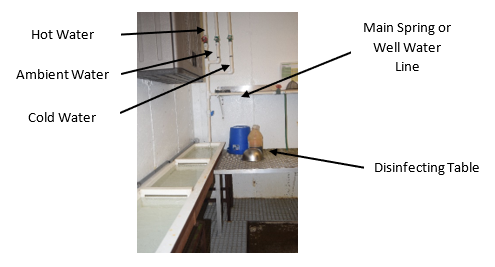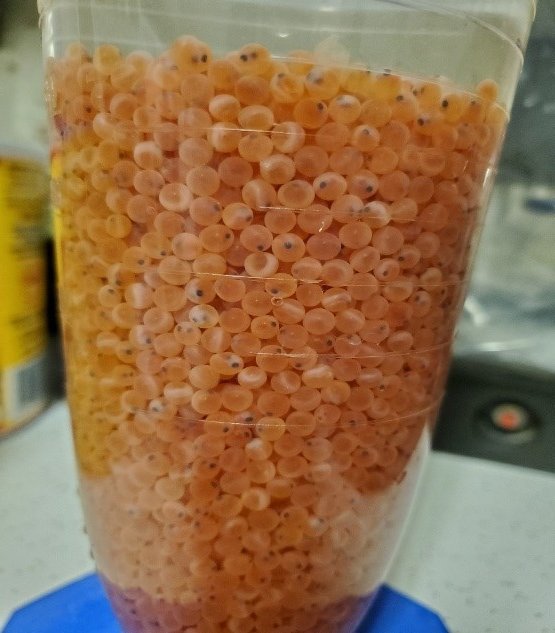Published on Dec. 19, 2019
Rehydrating, tempering and disinfecting fertilized trout eggs
Eggs are incubated at Troutlodge sites at an average of 5-10⁰C (40-50⁰F) and packed at a similar temperature. The ice that is packed in the boxes is designed to keep the eggs cool and moist during transportation. The eggs will cool by several degrees during shipment, and will also partly dehydrate in the shipping process.
On receipt, the eggs must be re-hydrated as soon as possible. Rehydration is essential. Eggs should be placed in cool, well oxygenated, flowing water for 45 minutes to 1 hour undisturbed.
Our own experience shows that tempering eggs is not as essential as effective rehydration. OIE guidelines and various national and regional legislation dictate that disinfection of incoming eggs is required. This should only be undertaken on completion of effective rehydration.
Placing eggs directly into incubators or rehydration systems (5-10C) can be less of a risk than a lengthy rehydration / acclimation process with poor water supply.
Many of our customers temper eggs and use techniques that have been tried and tested over the years. Their tempering and disinfecting process is usually a stand-alone system that is capable of mixing flowing water with temperatures to match the hatchery water. Also, eggs can easily be disinfected in these systems after tempering and rehydration has taken place. See Figure 1 below.

Figure 1: Stand-alone tempering and disinfecting station
Unfortunately we also have experience of customers using a simpler “eggs in a bucket” procedure for a prolonged period with little water exchange to acclimate to temperature. This can be a major problem as it risks suffocating the eggs due to poor water exchange.
Eyed eggs need lots of oxygen. Well eyed eggs left alone in standing water can suffocate in a matter of 15-20 minutes. See Figure 2 below.

Figure 2: Typical example of suffocated eggs. Notice the spines of the embryos have turned white and the general color of the eggs is pale orange.
Our own in-house studies have shown that eggs coming out of the shipping box and immediately placed in incubators with a range of temperatures (5C-12C), show little differences in hatching results and survival percentages. Please see our in-house tempering study at the end of this paper.
Should the shipping process have been delayed, please do not try to disinfect eggs that may already be hatching or are close to hatching as this may cause excessive mortality or deformity.
Disinfectants used in the procedure contain buffered iodine and should be administered as a 10-minute bath treatment at 100 parts per million (ppm) of free iodine. There are a variety of commercially produced iodine-based disinfectants available on the market such as Argentyne® Betadine® or Wescodyne®. Follow the manufacturer’s instructions carefully and ensure that the correct dosages are administered. Gently mix eggs and disinfectant to ensure that all egg surfaces are treated.
Iodine disinfectants, when correctly mixed, are dark brown in colour – when disinfecting large amounts of eggs, the colour may become notably paler or yellow in which case the dosage has been diluted and is no longer fully effective and should be replaced with a fresh batch.
After disinfecting, rinse the eggs with clean hatchery water to remove iodine residue before counting, measuring or placing them into incubators for hatching.
It is not advisable to use products that are not specifically designed for the disinfection of salmonid eggs.
Below is an in-house study Troutlodge conducted to show the effect of different water temperatures and time rates on hatchability. The results show that tempering is not as important as effective and immediate rehydration of eggs.
Tempering experiment:
Immediately placing eggs from box to different water temperatures and iodine disinfection.
- May group 3 year old female eggs.
- Held in Troutlodge shipping box with ice from 5/24/19 to 5/28/19.
- Total accumulated units 265.
- Temperature of eggs at removal from box .5C
- Ambient Temperature Water 7C
- Cold temperature 5.5C
- Heated flowing water at 12C
Test A - Sample testing from box directly to flowing water rehydration for 30 minutes and Iodine treatment for 10 minutes.
- Eggs 1C to 5.5C Water (6% deformities, 91.5% survival)
- Eggs 1C to 7C Water (5.5% deformities, 92% survival)
- Eggs 1C to 12C Water (4.5% deformities, 95.5% survival)
Test B - Sample testing from box directly to flowing water rehydration for 10 minutes and Iodine treatment for 10 minutes.
4. Eggs 1C to 5.5C Water (5% deformities, 92.5% survival)
5. Eggs 1C to 7C Water (6% deformities, 90% survival)
6. Eggs 1C to 12C Water (7.5% deformities, 92% survival)
Test C - Sample testing from box directly to non-flowing 12C rehydration and immediate iodine for 10 minutes, then directly into 12C incubation water.
7. Eggs 1C to 12C Water (3% deformities, 96.5% survival)
